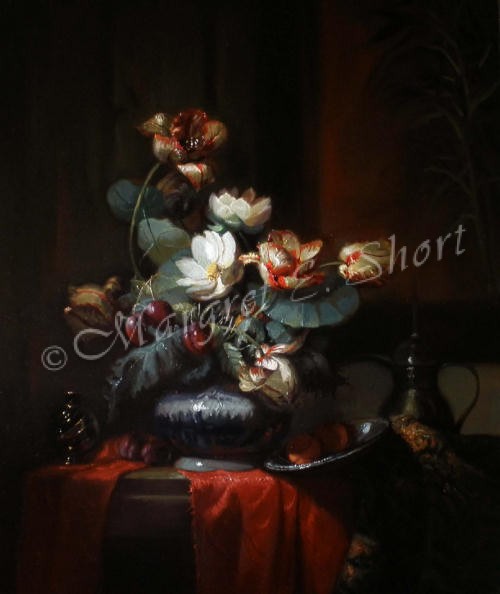
Lessons from the Pharaoh’s Tomb, Part Two
Cleopatra’s Garden, shown above, evolved over a period of time with a “cultural blending” of ideas. My artistic license is used liberally throughout the process with many differing objects from various cultures in the composition. The “garden” is from imagination depicting favorite flowers and found objects from my studio and blends Egyptian, Dutch, and Turkish life.
The Turkish coffee pot in the shadows to the right was purchased in an antique shop years ago and fits perfectly here. It is brass with lovely decorative markings etched into the surface. The central crockery vase is also an antique shop find and shows a European old world village with buildings across the lower area. The muted grays and blues are painted with black, white, and Egyptian blue.
As you have most likely guessed tulips are my favorite flower and also a splendid challenge to paint. This particular variety was among the many we grow in our garden and conveniently bloomed with perfect timing in early spring. Initially, I feared I would not be able to achieve the brilliance of the red in the stripes, but the combination of red iron oxide and madder made a perfect hue. Malachite, yellow ochre, and white created the various shades needed for the lighter stripes. The legendary image of the lotus blossoms added the Egyptian touch to the grouping and are painted with the same shades of white.
Those of you who have traveled to Egypt and have survived the “Khan el-Khalili Market” experience will relate to my challenging purchase of the bright red scarf, shown in the foreground. The street vendors can be insistent; nonetheless, the scarf is a colorful addition both to my prop collection and to this composition. The perfume bottle peeking from the left shadows is another memorable market purchase.
The additional items are inserted into the design to create balance and add to the cultural variety, such as the Dutch style rug in the right foreground. Interestingly, peaches were introduced into Egypt in the Ptolemaic period, 332-30 BC. The plums? Well, again they round out the composition and are perfect foils for utilizing Egyptian blue and madder, and satisfying artistic license one more time.
Galerie Gabrie, Pasadena
